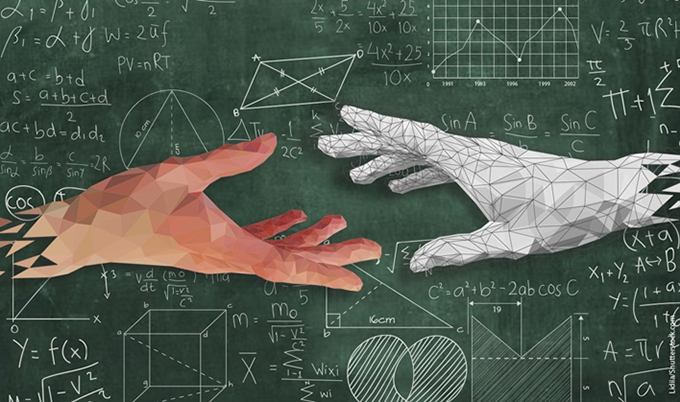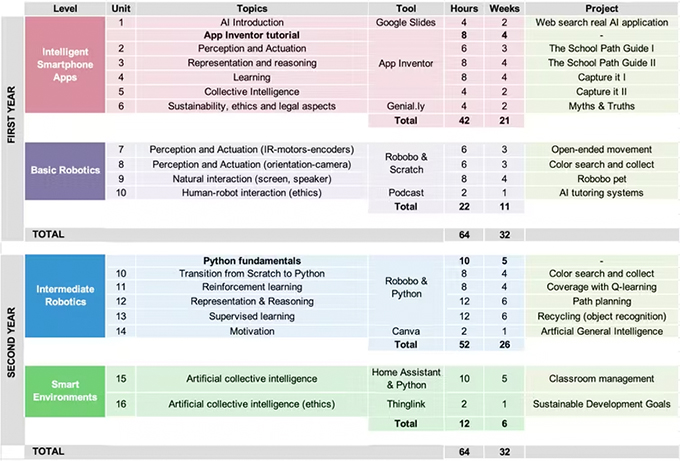 Lucía is 16 years old and has been using her cell phone for almost everything for four years. But this year, in her Artificial Intelligence (AI) class at her high school, she has used it for something she never imagined was possible. Through the camera, microphone and touch screen of her own smartphone, and using a free app, she has turned it into a pet robot, which interacts with her as if it were alive: it asks for food, attention, to play with the…
She has achieved all of this by programming herself with the Robobo educational robot in teaching unit 9 of the AI+ project , dedicated to the interaction between human and robot. This is just one example of the kind of activities that she has designed by the AI+ team over the past three years with the goal of creating an AI curriculum for students between the ages of 15 and 17 (High School).
And why teach artificial intelligence to pre-university students? Because young people must already understand how it works, and thus be prepared to be able to live in a world increasingly impacted by it, in addition to being able to train to be the future AI engineers.
Lucía is 16 years old and has been using her cell phone for almost everything for four years. But this year, in her Artificial Intelligence (AI) class at her high school, she has used it for something she never imagined was possible. Through the camera, microphone and touch screen of her own smartphone, and using a free app, she has turned it into a pet robot, which interacts with her as if it were alive: it asks for food, attention, to play with the…
She has achieved all of this by programming herself with the Robobo educational robot in teaching unit 9 of the AI+ project , dedicated to the interaction between human and robot. This is just one example of the kind of activities that she has designed by the AI+ team over the past three years with the goal of creating an AI curriculum for students between the ages of 15 and 17 (High School).
And why teach artificial intelligence to pre-university students? Because young people must already understand how it works, and thus be prepared to be able to live in a world increasingly impacted by it, in addition to being able to train to be the future AI engineers.
The AI+ project
AI+ is an educational innovation project that has been funded by the European Union through the Erasmus+ program. It encompasses six secondary schools in five different countries (Spain, Italy, Slovenia, Lithuania and Finland). The project is led by a group of experts from the Universidade da Coruña (UDC), which has implemented specific didactic units that make up the study plan. These contain theoretical concepts and practical activities on eight basic areas of artificial intelligence :- Perception.
- Performance.
- Representation.
- Learning.
- Reasoning.
- Motivation.
- Collective artificial intelligence.
- Social impact.

AI+ Project Curriculum
The ‘intelligent agent’
The artificial intelligence approach followed in the AI+ project is that of the intelligent agent . Artificial intelligence systems are presented to students as autonomous computational systems capable of sensing their environment, real or simulated, and taking actions to meet their goals. This perspective is in line with the recommendations of the European Commission and the Ministry of Science, Innovation and Universities for future digital education plans, focused on “specific AI”, that is, the one that faces real environments that solve problems specific to people.Smartphone, AI tool
In order to implement this approach in the classroom, it is necessary to have specific hardware elements . In our case, we decided to use the student’s smartphone as the basic technological element for all the didactic material developed. Today’s smartphones have the necessary technological level in terms of sensors, actuators, computing power and communications, and they will also have it in the future given their continuous updating. In addition, the vast majority of high school students have their own smartphone , which significantly reduces the cost of introducing this discipline in the classroom and equalizes regions with different economic capacity.Real problems
To introduce the eight topics of AI discussed above, students are faced with real problems belonging to three specific fields of application :- Smart apps for phones.
- Autonomous robotics.
- Smart environments (internet of things).